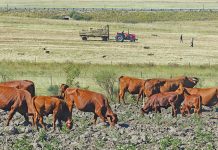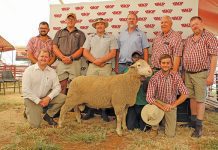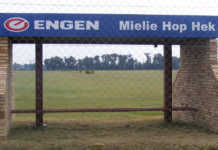Brothers Francois and Cobus Uys own the Patryskraal Stud near Bredasdorp and have been dominating the SA Merino Championships for the past 10 years. Cobus shares the secret of their success.
There’s nothing you can tell brothers Cobus and Francois Uys, owners of the Patryskraal Stud, about wool quality. They’ve dominated the SA Merino Championships by winning the division for the Ram with the Best Fleece for the past 10 years.
A family history of excellence
They attribute the excellent quality of the stud’s wool to a long family history of sound selection practices combined with a good feeding regime. The brothers’ great great-grandfather, Cornelius Janse Uys, started farming with mixed sheep at Patryskraal just outside Bredasdorp in the southern Cape around 1831. Sheep production was then the main income generator, as it was near impossible to cultivate anything in the harsh renosterveld.
His grandson, Cornelis Janse III, established the Patryskraal Stud in 1918. Cobus and Francois’ father, also Cornelis Janse Uys, turned the stud into one of South Africa’s finest when he imported two rams from the Collinsville Stud in Australia around 1981. “My father imported these rams to get new genetics into the stud and improve wool quality. He was devoted to the production of quality fine wool,” Cobus says.
Production aims
Today the brothers aim to produce larger-framed, fast-growing animals that are market ready at five to six months, as 70% of sheep income is generated through meat sales. Producing bigger-framed animals has been made possible by the high protein forage produced on the farm (see box: Diversifying with cash crops and livestock). The brothers’ objective is to produce sheep with a heavy carcass of 48kg instead of 40kg without extra fat. This extra 8kg translates into an additional R100 at the current mutton price. But this doesn’t mean wool production is neglected, with wool micron diameter averaging around 19,5. They also aim to improve the length and smoothness of the wool, as wool production makes up 30% of the income from sheep.
Focusing on feed
Cobus sees feed as an important factor in animal performance. “Wool Merinos are always winners if you look after them, because they help diversify risk.” Lucerne, grass, wheat and barley stubble are used as forage in summer. With the region’s erratic rainfall, it’s sometimes necessary to feed animals in summer. Cobus then rather spares his weaker producing pastures and supplies the sheep with straw bales and strategic licks. Sheep also receive Voermol’s specially formulated licks for finishing off sheep.
Managing ewes and lambs
To enhance reproduction, ewes receive lupins as a stimulus four to six weeks before mating. Cobus explains good feed can result in a 10% to 15% rise in reproduction figures. Maxi-wool – a high protein formula – is given as carryover feed four to six weeks before lambing to ensure ewes have sufficient and good quality milk for their offspring. Young ewes are kept on the best forage so they’ll be able to reproduce and support a lamb at 18 months. Cobus says young ewes should weigh at least 45kg to 50kg at 12 months to ensure a high conception rate.
There are around 700 ewes in the stud, depending on market and veld conditions and the number of newborn animals. Young ewes make up around 20% and mature ewes 65%. The stud is divided into two equal groups according to two lambing seasons. The one group lambs in February and the other in August to compensate for the erratic climate. All the stud ewes are artificially inseminated. Rams are rotated amongst five family groups to prevent inbreeding and to improve heritage lines. This type of breeding is also easier considering the size of the stud and the commercial flock of 2 400 ewes. Ewes carrying twins are kept in small flocks of 20 to 30, while the other ewes are in flocks of 50 to 60 animals.
Developing maternal qualities
Cobus says he no longer uses lambing sheds. “I expect the ewes to look after their offspring because I provide them with sufficient high-quality feed.
I think this practice improves maternal qualities.” Ewes that don’t look after their lambs are culled without exception.
Excellent lambing percentages
A lambing percentage of around 105% and 125% is maintained for the winter and spring group respectively. Weaning percentages for the year are around 110%, depending on fodder flow and rainfall patterns. Lambs receive creep feed when they are a month old to get used to being fed. This is especially important during drought. Lambs are weaned at a 100 days when they weigh around 25kg to 30kg. Ewe and ram lambs are also separated at this stage. “Removing lambs from the mothers too early could result in the lambs not being used to feeding on their own. These rams never seem to catch up with the rest of the flock and they’re also more susceptible to diseases. On the other hand, lambs removed too late cause ewes to take longer to recover and this can have a negative impact on the next year’s lambing percentage,” Cobus says.
Stringent selection
There’s a strict selection process once the ewes are 12 months old. All the young ones conforming to the breeding standards of Merino SA are retained in the stud, while the others are transferred to the commercial flock. These are also classed and individuals not conforming to the commercial flock’s standards are placed with an SA Mutton Merino ram for a terminal crossing. Non-conforming qualities include ewes with reproduction problems, poor quality wool or excessive skin folds. These ewes and their offspring are then sold to the local abattoir.
Around 100 rams are selected and subjected to linear testing when they’re 12 months old. At this age they’ve been scored and weighed for performance testing. At 18 months, they’re put up at the local production auction. Linear testing has produced excellent results on the farm for the past 30 years and comprises a subjective evaluation of conformation and wool.
Cobus also benchmarks his stud rams against those from other farms. He feels progeny testing is helpful for selection and often uses BLUP values when buying in rams. But he doesn’t use progeny testing as he feels linear testing is sufficient to help him fulfil his goals. Around 40 rams in the summer group are selected – the top 10% sold on auction. The winter rams are all maintained at Patryskraal.
Diversifying with cash crops and more livestock
“The Patryskraal Stud has sentimental value to us, but we need to be realistic in the current economic climate,” says Cobus Uys. Production has been diversified to reduce risk, so sheep production only accounts for 30% of the farm’s income.
Modern planting equipment made the cultivation of cash crops possible on the farm. This has significantly improved sheep and land use efficiency.
Of the 2 000ha of arable land on the farm, 45% is under cash crops and the rest under lucerne.
A six or seven year rotation of wheat, canola and barley, followed by a seven year lucerne phase, is followed. Some 30ha to 40ha are under lupins. A herd of 80 Nguni cows are run in marginal veld. Young oxen are weaned on the veld and finished off on cultivated pastures.
Ostriches are also produced and chicks are raised in Bonnievale because the air is too moist for chick production in Bredasdorp. These birds are returned to the farm and then either used for breeding or finished off for the market.








